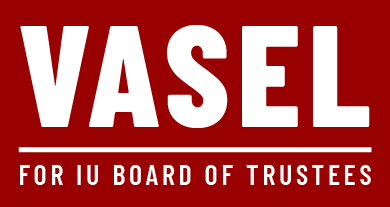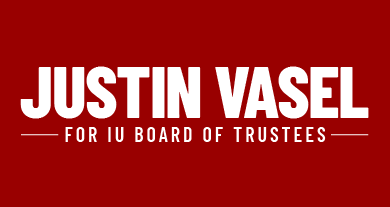In recent discussions about university governance reform, critics of Indiana University’s alumni-elected trustee positions have cited declining voter participation as evidence that alumni have lost interest in university governance. This narrative has gained traction among those advocating for the elimination of these positions altogether. However, a comprehensive analysis of election data from 2000-2024 reveals a more nuanced reality: the decline in voter participation coincides precisely with a significant procedural change in how elections are conducted.
The Procedural Shift and Its Consequences
For decades, Indiana University automatically sent paper ballots to all alumni for Board of Trustees elections. However, in 2010, this practice changed dramatically. While online voting had been previously introduced as an option, 2010 marked the year when paper ballots were no longer automatically distributed to all alumni. Instead, alumni had to specifically request a paper ballot—a procedural hurdle that immediately and dramatically impacted participation.
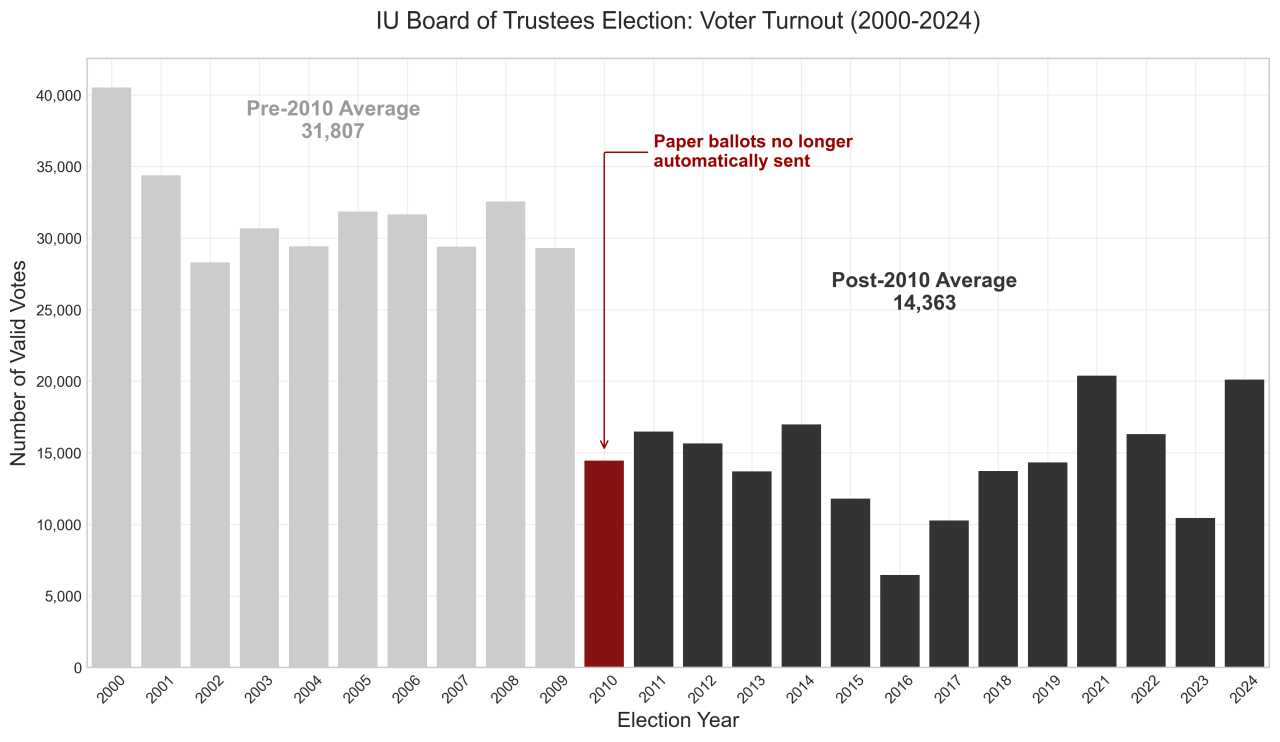
The data tells a compelling story. Prior to 2010, voter turnout in trustee elections remained relatively stable, averaging approximately 31,807 votes per election. After 2010, this number plummeted to an average of just 14,363 votes—a staggering 54.8% decrease. This precipitous decline strongly suggests that the issue is not alumni disinterest but rather a procedural barrier that effectively removed many alumni from the electoral process.
A Defining Moment of Participation Collapse
The year-over-year analysis provides even more striking evidence of this procedural impact. Between 2009 and 2010, voter participation dropped by an unprecedented 50.7%—the largest single-year decline in the entire 24-year dataset.
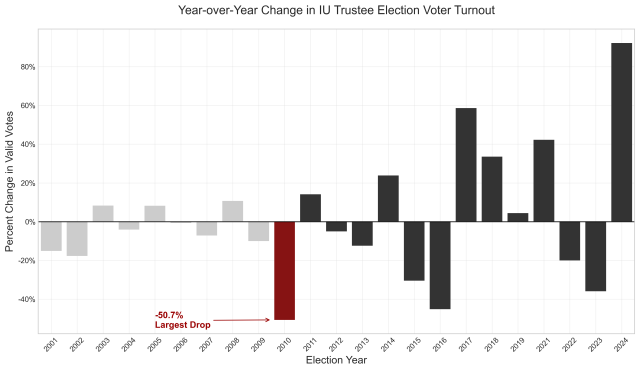
What makes this drop particularly noteworthy is its anomalous nature. In the years preceding 2010, fluctuations in voter turnout typically ranged between -18% and +11%, reflecting normal electoral cycles. The 2009-2010 drop stands far outside this pattern, suggesting an external factor—the procedural change—rather than a sudden collapse in alumni interest.
Statistical Evidence of a Systemic Shift
When examining the statistical distribution of voter participation before and after 2010, the evidence becomes even more compelling. The boxplot comparison demonstrates that even the highest participation rates after 2010 barely reach the lowest participation rates from the pre-2010 era.
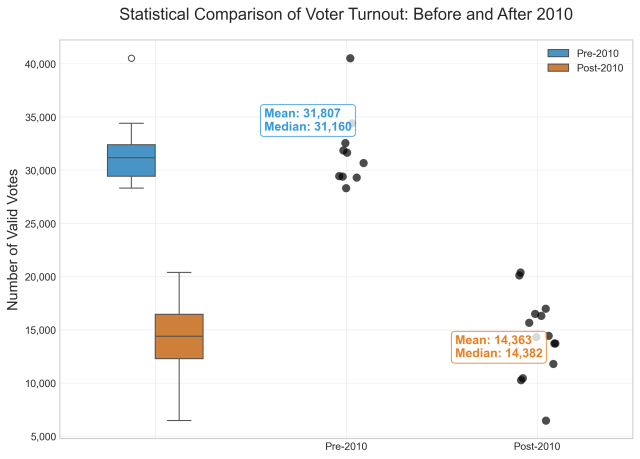
The median voter turnout before 2010 was 31,160 votes, compared to just 14,382 votes after the change. This represents a fundamental shift in the electoral landscape—one that correlates directly with the procedural modification rather than gradual disengagement.
Implications for University Governance
These findings have profound implications for discussions about the future of alumni-elected trustee positions at Indiana University. Rather than indicating alumni apathy, the data strongly suggests that administrative changes in the electoral process created substantial barriers to participation.
The argument for eliminating alumni-elected trustee positions based on low turnout becomes significantly weaker when we understand that this decline is largely attributable to procedural changes. Moreover, recent elections with higher candidate counts (particularly 2021 and 2024) have shown notable increases in participation despite these barriers, further undermining the disinterest narrative.
Restoring Alumni Voice: Practical Policy Recommendations
While returning to automatic distribution of physical ballots may be financially prohibitive in today’s digital environment, several targeted policy interventions could substantially increase alumni participation without incurring excessive costs:
1. Enhanced Digital Communication Strategy
The current practice of sending a couple of informational emails during the election period is clearly insufficient. A more robust approach would include:
- Segmented messaging targeting different alumni demographics with tailored messaging
- Integration of election information into other routine alumni communications throughout the year
- Use of multiple channels beyond email, including social media campaigns and alumni portal notifications
2. Streamlined Digital Voting Experience
- Implement one-click voting access from notification emails
- Ensure a mobile-friendly voting interface that works seamlessly across devices
- Reduce the number of authentication steps required while maintaining security
3. Enhanced Candidate Visibility and Information
Many alumni may be unaware of who is running or why these positions matter.
- Create standardized candidate profile formats that highlight qualifications and positions on key university issues
- Host virtual candidate forums accessible to alumni worldwide
- Feature candidate statements in alumni magazines and newsletters
- Develop an interactive comparison tool to help voters evaluate candidates
4. Procedural Modernization
- Explore an opt-out rather than opt-in system for physical ballots for alumni who have never participated digitally
- Create a persistent voter registration system allowing alumni to pre-register their voting preferences
- Explore the possibility of a hybrid mail/digital notification system that sends physical postcards with QR codes linking to digital voting
5. Institutional Commitment to Electoral Significance
- Include information about trustee elections in regular communications from university leadership
- Highlight the impact of recent trustee decisions on university policy and direction
